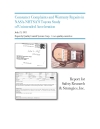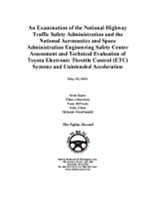August 23, 2011
A new technical paper from the research scientists at the University of Maryland’s Center for Advanced Life Cycle Engineering (CALCE) buttresses the findings of the National Highway Traffic Safety Administration and NASA’s Engineering Safety Center investigation into Toyota unintended acceleration: Toyota vehicles with potentiometer type accelerator pedal position sensors have a propensity to grow tin whiskers that can and do cause shorts in a highly sensitive engine management area.
Researchers Bhanu Sood, Michael Osterman and Michael Pecht studied a pedal assemblies performed a physical analysis of an engine control system from a 2005 Camry XLE, V-6 and an accelerator pedal assembly from a defunct 2002 Camry. The 2005 engine control system included the ECM, an accelerator pedal unit, throttle body, electrical connectors and electrical connecting cables.
August 2, 2011
Among safety advocates’ most vociferous criticisms of NHTSA and NASA’s investigation into Toyota Unintended Acceleration were the copious black smears over key bits of data and text in their twin reports released last February. These redactions have kept independent scientists from knowing exactly what the investigators did, irrespective of assessing the quality of the research. (See: How NHTSA and NASA Gamed the Toyota Data)
Alice and Randy Whitfield of Quality Control Systems Corporation, ever the assiduous students of NHTSA’s statistical and informational folkways, went for broke. Shortly after the reports were released, they filed a Freedom of Information Act request for non-redacted versions of the reports and supporting material that was missing from the record. In response, NHTSA publicly released some of the information in the form of less redacted versions of Technical Assessment of Toyota Electronic Throttle Control (ETC) Systems and Technical Support to the National Highway Traffic Safety Administration on the Reported Toyota Motor Corporation Unintended Acceleration Investigation, but continued to withhold other information.
July 25, 2011
The Senior Judge of the Florida’s Fifth Judicial Circuit has set aside a jury verdict in favor of Ford Motor Company, blasting the automaker for defrauding the court and the National Highway Traffic Safety Administration by claiming that it knew of no other cause of unintended acceleration than driver error and for concealing years of testing that showed that electromagnetic interference was a frequent root cause of UA in Ford vehicles.
In his withering decision, Senior Judge William T. Swigert of the Fifth Judicial Circuit in Sumter County, Florida ordered a new trial in which the jury would only consider compensatory and punitive damages in Stimpson v. Ford. The post-trial order is a victory for Attorney Thomas J. Murray, of Murray & Murray based in Sandusky, Ohio, who represented the Stimpson family.
The case concerned an October 28, 2003 crash which left Peggy Stimpson permanently paralyzed. Her husband alleged that he was unable to stop the couple’s 1991 Ford Aerostar, when it suddenly accelerated from their carport as he put the van into gear. The Aerostar hurtled more than 100 feet, and crashed into a utility pole.

July 21, 2011
Alice and Randy Whitfield of Quality Control Systems Corp. have released a new analysis for Safety Research & Strategies that examines the statistical underpinnings of the NHTSA and NASA reports on Toyota Unintended Acceleration which shows that the agencies based their conclusions about the possibility of an electronic cause on a series of unsupportable suppositions, miscoded data and secret warranty data reported by Toyota’s litigation defense experts, Exponent.
June 20, 2011
That an infant seat should be placed in the rear-seat of the car, facing rearwards is an article of faith, preached by the National Highway Traffic Safety Administration and the American Academy of Pediatricians. Manufacturers only make rear-facing infant seats.
On its website, NHTSA advises:
“A rear-facing car seat is the best seat for your young child to use. It has a harness and in a crash, cradles and moves with your child to reduce the stress to the child’s fragile neck and spinal cord. Your child under age 1 should always ride in a rear-facing car seat.”
But Transport Canada researcher Suzanne Tylko presented data at the biennial Enhanced Safety of Vehicles conference that questions the certainty of that policy. Transport Canada has been at the forefront of child motor vehicle crash safety research. In particular, the agency’s dynamic testing has yielded important insights. In this three-year study, TC tested 131 child restraints in 85 motor vehicle crash tests. The vast majority were rigid barrier tests on rear-facing infant seats, secured by a three-point belt conducted at speed of 48km/h; 11 were conducted at 56 km/h; and seven were conducted at 40 km/h. TC also tested seats in offset deformable barrier tests, conducted at 40 km/h. (Fourteen tests involved convertible seats installed facing the rear.)
June 16, 2011
FDA News, a purveyor of U. S. Food and Drug Administration regulatory and international standards compliance newsletters, books, special reports and conferences, gathered the medical devices industry to a come-to-Jesus meeting last week and the warnings were stern: quality has been low and the number of U.S. Food and Drug Administration warnings and recalls is high. Medical device manufacturers haven’t met the bar for quality control and the regulations are about to get a whole lot tighter.
Presenters at the three-day conference on risk management and post-market surveillance reeled off a list of unhappy statistics:
Adverse events are growing faster than the market. Infusion pumps, automated external defibrillators and catheters produced 65 percent of the serious adverse events from 2005-2009, according to FDA data.
In 2010, the FDA issued 89 warning letters for Quality Systems deficiencies.
Nearly one-third of all medical device recalls occur as a result of design and/or manufacturing defects and root cause analyses shows that there are wide gaps in product design, manufacturing process control, and supplier management. (The FDA can also require a recall based on a wide variety of non-conformance issues including bad record-keeping, failing to report death and injuries associated with a device and failure to establish a corrective action plan.)
June 9, 2011
Back in February, SRS wrote to the National Highway Traffic Safety Administration, the Alliance of Automobile Manufacturers and National Mobility Equipment Dealers about the problem of car seat heaters and drivers with lower body sensory deficits, such as paraplegics and diabetics (See It’s Time to Make Seat Heaters Safer). Many consumer heating devices that make direct contact with the body, such as electric blankets, are designed with maximum temperature limits, but not so in the auto industry. In the absence of any regulation or industry standard, vehicle manufacturers have implemented a variety of designs, some of which lack an automatic cut-off and reach maximum temperatures that can produce third-degree burns or both.
For occupants who have limited or no sensations below the waist, these designs are dangerous. The medical literature has been documenting severe burns suffered by disabled drivers and passengers from car seat heaters since 2003, and nationally recognized burn care specialists joined our effort to engage adapters, regulators and manufacturers in averting these preventable injuries.
June 3, 2011
We here at the Safety Record Blog are getting caught up on our blogging after a hectic before-the-holiday-weekend week attending Edmund.com’s Let’s Blame it on the Drivers conference and releasing our response to the NHTSA and NESC report on Toyota. If you haven’t had a chance to read this special edition of The Safety Record, you can catch it here.
And son of a gun if Toyota didn’t release its long awaited quality report on the same day! (A little awkward, we know.) This panel of Very Serious People outside of the company was charged with the task of evaluating just what went wrong:
“The Charter directs the Panel to conduct a thorough and independent review of the soundness of these processes and provide its assessment to Toyota’s senior management.”
May 26, 2011
SRS was in attendance, Tuesday, as the cyber sales team at Edmund’s ushered in a “new chapter in the conversation between government, the auto industry, safety advocates, academics and consumers, marked by thoughtful, data-driven contributions from all.”
It was written amid cocktails and at more sobering and highly-scripted venues inside the Newseum, the 250,000 square-foot monument to journalism in Washington DC. If Edmund’s is going to author the new chapter on safety, consumers beware.
In the conference brochure, Edmund’s CEO Jeremy Anwyl tells participants that the Toyota Unintended Acceleration crisis was the impetus for the meeting: “Edmunds.com watched as a shallow conversation made international headlines. We felt uneasy about the lack of real discussion taking place among smart people with the power to change laws, introduce technology and educate drivers.”

May 23, 2011
REHOBOTH, MASS – The Safety Record, Safety Research & Strategies’ watchdog publication, published its new findings on the National Highway Traffic Safety Administration (NHTSA) and the NASA Engineering and Safety Center (NESC) reports on Toyota Unintended Acceleration. Following extensive review of those reports and previously unavailable documents recently released by NHTSA and interviews with numerous scientists and experts, the authors found that: